Mt Shasta Backcountry One-Day Summit
On Memorial Day Sunday, Dan, Tank, Sam, and I successfully summited and skied down Mount Shasta (14,179ft / 4,322 m) in a one-day push. Dan and Tank were fairly experienced with backcountry skiing, but this was Sam and my first time on backcountry skis. It was also my first time using crampons, an ice axe, summiting a 14er, and the first time I’d ever been above 11k feet. Perhaps most importantly, this was also the first time on skis since I’d torn my ACL skiing last year and was approximately 1 year after my ACL repair surgery. Needless to say, this was a big effort, and I was very nervous heading into the weekend.
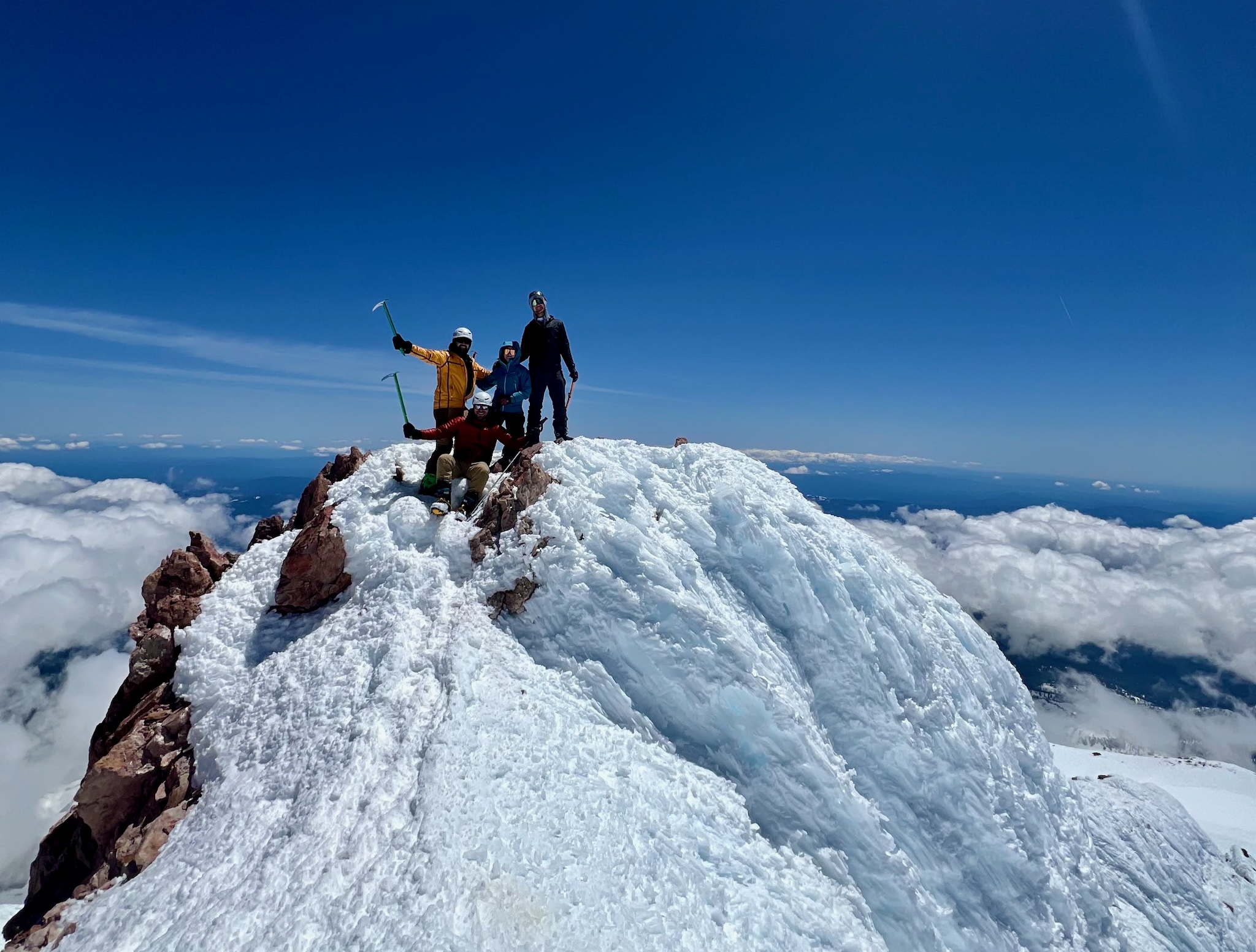 Nick, Sam, Tank, and Dan at the summit of Mt Shasta (14,179 ft / 4,322 m)!
Nick, Sam, Tank, and Dan at the summit of Mt Shasta (14,179 ft / 4,322 m)!
Preparation
We drove up Friday after work and checked into our room at the LOGE Mt Shasta. It was an awesome outdoor adventure base, with a mountain bike rental shop, campsites, a communal campfire and kitchen, and a hammock, bike hooks, a ski rack, and free outdoor gear to use in our room!
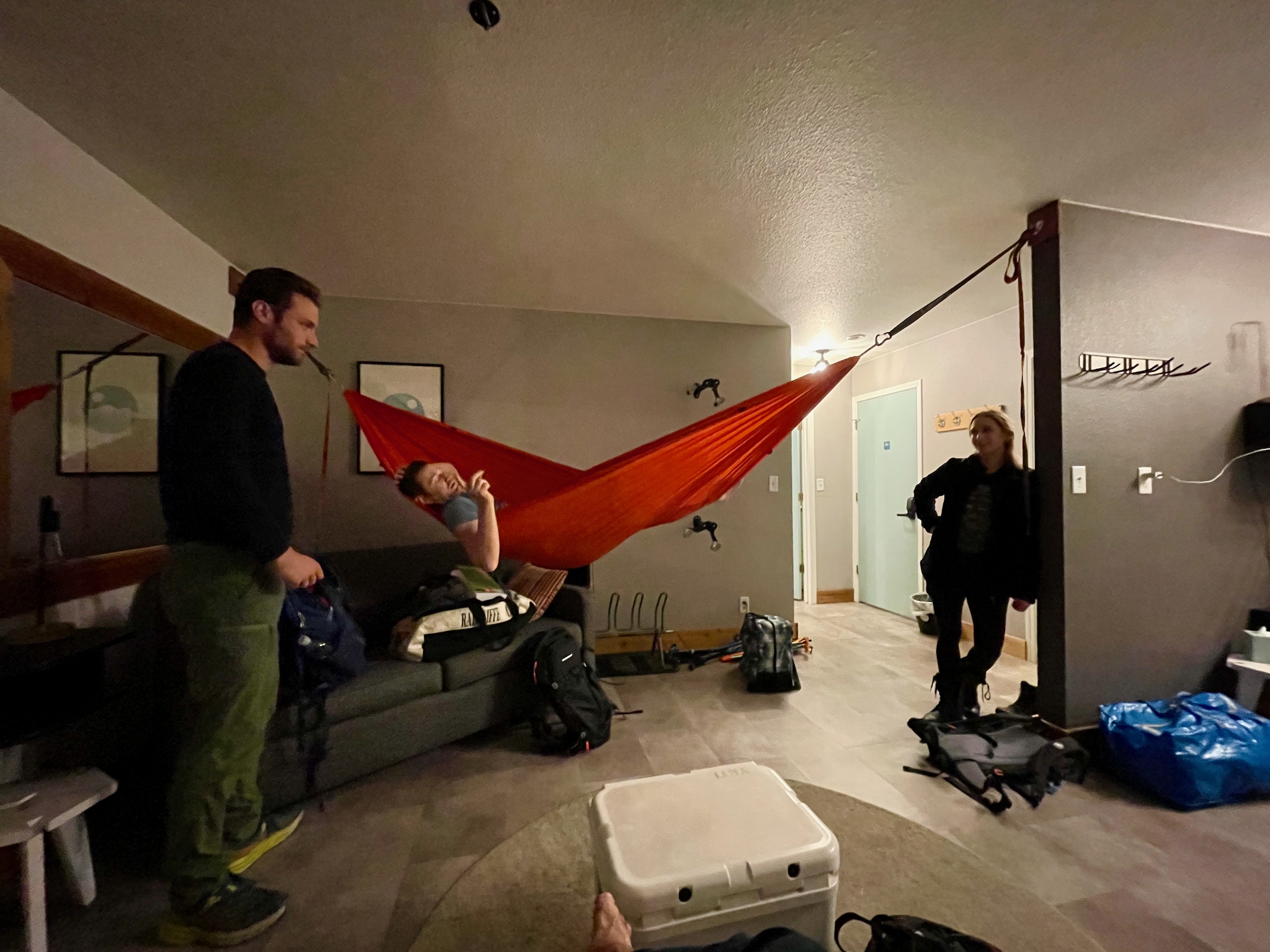 Hanging at the LOGE.
Hanging at the LOGE.
On Saturday, we woke up and headed to Fifth Season where Sam and I picked up our rental gear. This included a backcountry setup of skis, skins, ski crampons, boots, helmet, poles, boot crampons, and an avalanche beacon. We also borrowed packs, avalanche probes, and shovels from Dan and Tank.
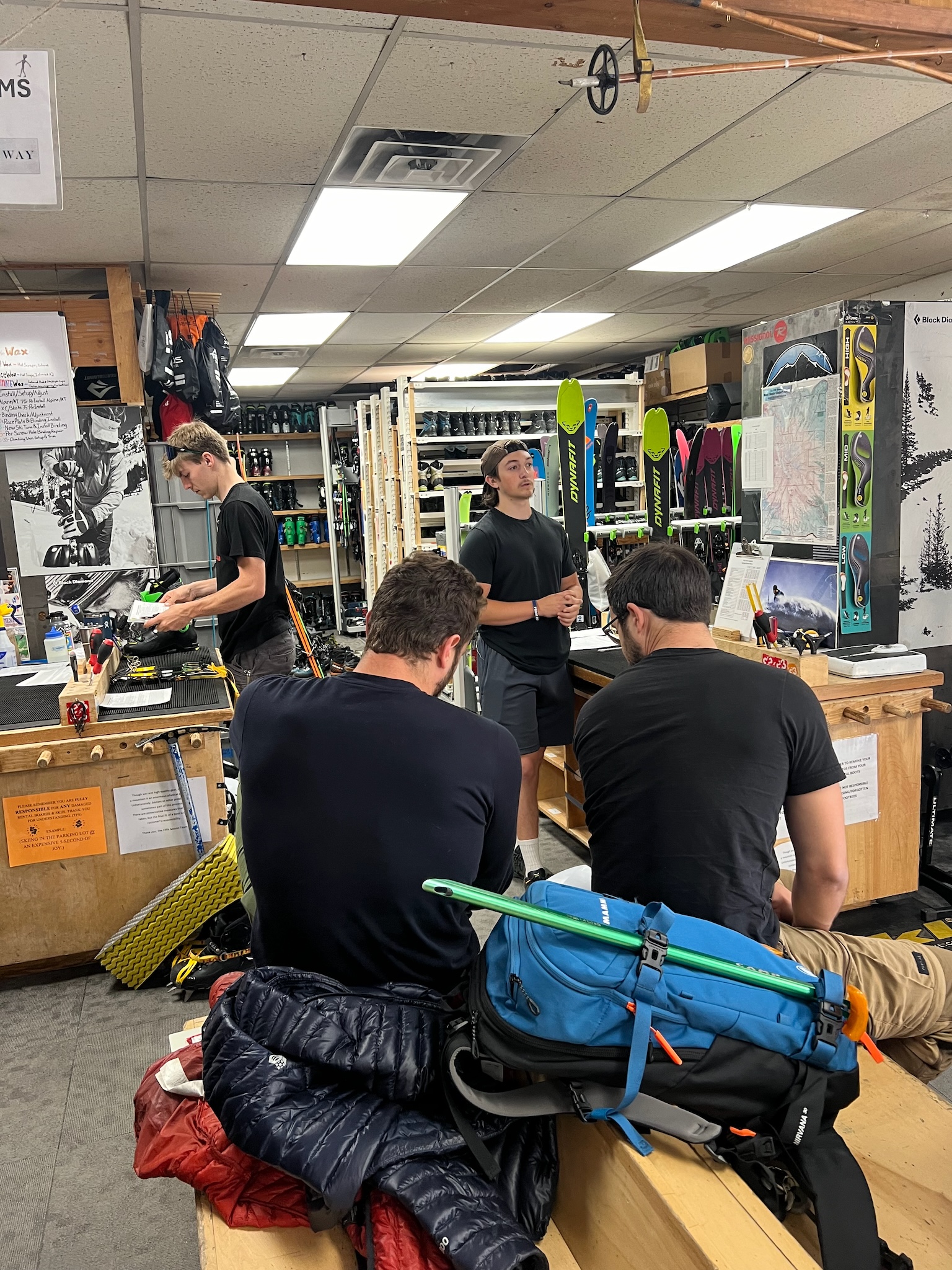 Renting gear at The Fifth Season outfitters.
Renting gear at The Fifth Season outfitters.
We then headed to Bunny Flats where Dan led a quick tutorial on how to use our equipment and not die on the mountain. We donned our boots and stuck the skins to the bottom of our skis, then headed out up the hill to practice skinning on flats and slopes with the risers. After skiing back down, we switched to crampons and practiced side-stepping and self-arresting with our ice axes. Finally, we discussed avalanche safety and practiced using our beacons to locate a “missing” person, probing, then digging them out of the snow. For me, all of this was brand-new and even the skiing felt awkward after a year off skis and using new equipment on icy snow filled with sun-cups. However, after our 1.5hr crash course of mountaineering skills we headed back to eat, grab supplies, prep our gear, and sleep.
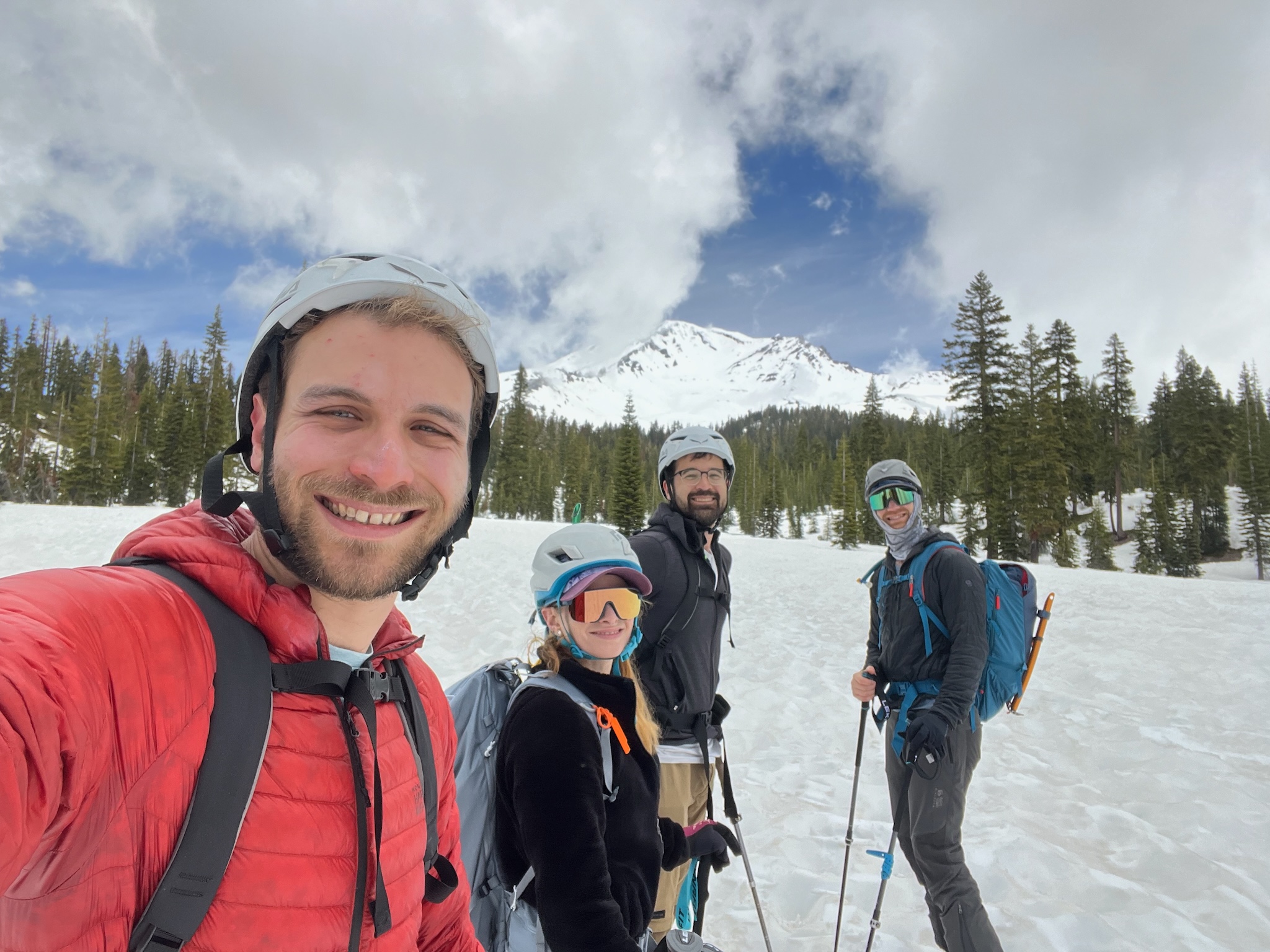 Celebrating a successful tutorial of how to use backcountry skis, crampons, ice axes, and avalanche gear at Bunny Flats.
Celebrating a successful tutorial of how to use backcountry skis, crampons, ice axes, and avalanche gear at Bunny Flats.
After gathering everything and signing our permits, we all popped melatonin and sleeping pills around 5:30pm in preparation for an 11pm wake-up.
The Route
We planned to follow the Avalanche Gulch route and skin up as far as we could, then switch to crampons and pack our skis to the summit before skiing down. We estimated that it would take 11-13 hours to summit, and 2-3 hours to ski down. By leaving at midnight, this would put us at the summit around noon and back at the car around 2-3pm.
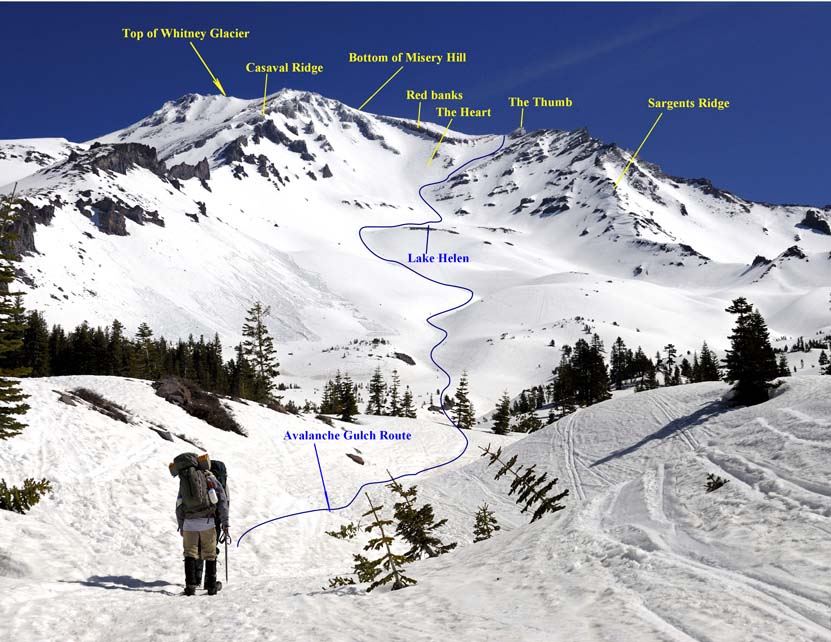 Overview of our planned route. ( source)
Overview of our planned route. ( source)
We all managed to sleep around 5.5 hrs and woke up at 11pm to pack the car. We were on the road by 11:30 and made it to the Bunny Flats trail-head by midnight. The parking lot was absolutely filled for Memorial Day, which meant I had to drop everyone off and go park a mile down the road. After one last attempt to poop, we were on our skis skinning into the darkness by 12:30am.
Skinning to Helen Lake
Our spirits were high as we started skinning up the trail from Bunny Flats (6,950 ft). Thank was taking a comfortable easy pace, while Sam and Nick went out fast and got far ahead before we chilled and met back up. The night was eerie but beautiful, and while there were a few others on trail it was mostly empty.
We skinned about 3 miles and gaining +3,490 ft to Helen Lake. About two hours in, the trail started to get progressively steeper. Dan and Tank had no trouble, but Sam and I struggled to keep our skins from slipping. About halfway to Helen Lake, we installed our ski crampons, which helped a good bit. I still struggled with the steep slopes until Dan suggested I remove my ski heel risers - this meant that I would get more grip from my ski crampons, but would need more flexible ankles on the steep slopes. This helped a ton and we continued out.
As we approached the last slope to Helen Lake around 4am, the slope got very steep (50% grade) and icy. Despite serpentining and picking my steps carefully, I was increasingly terrified of slipping and falling down the slope. The was made extra scary by the fact that if you fall with backcountry skis in walk mode, the skis are not designed to release. I was moving so slowly with the skis that I eventually decided to switch to boot crampons, as I figured it would be both safer and faster for me. This helped enormously, and I was able to make it up the last 0.1 mi to Helen Lake (10,440 ft) around 4:20am.
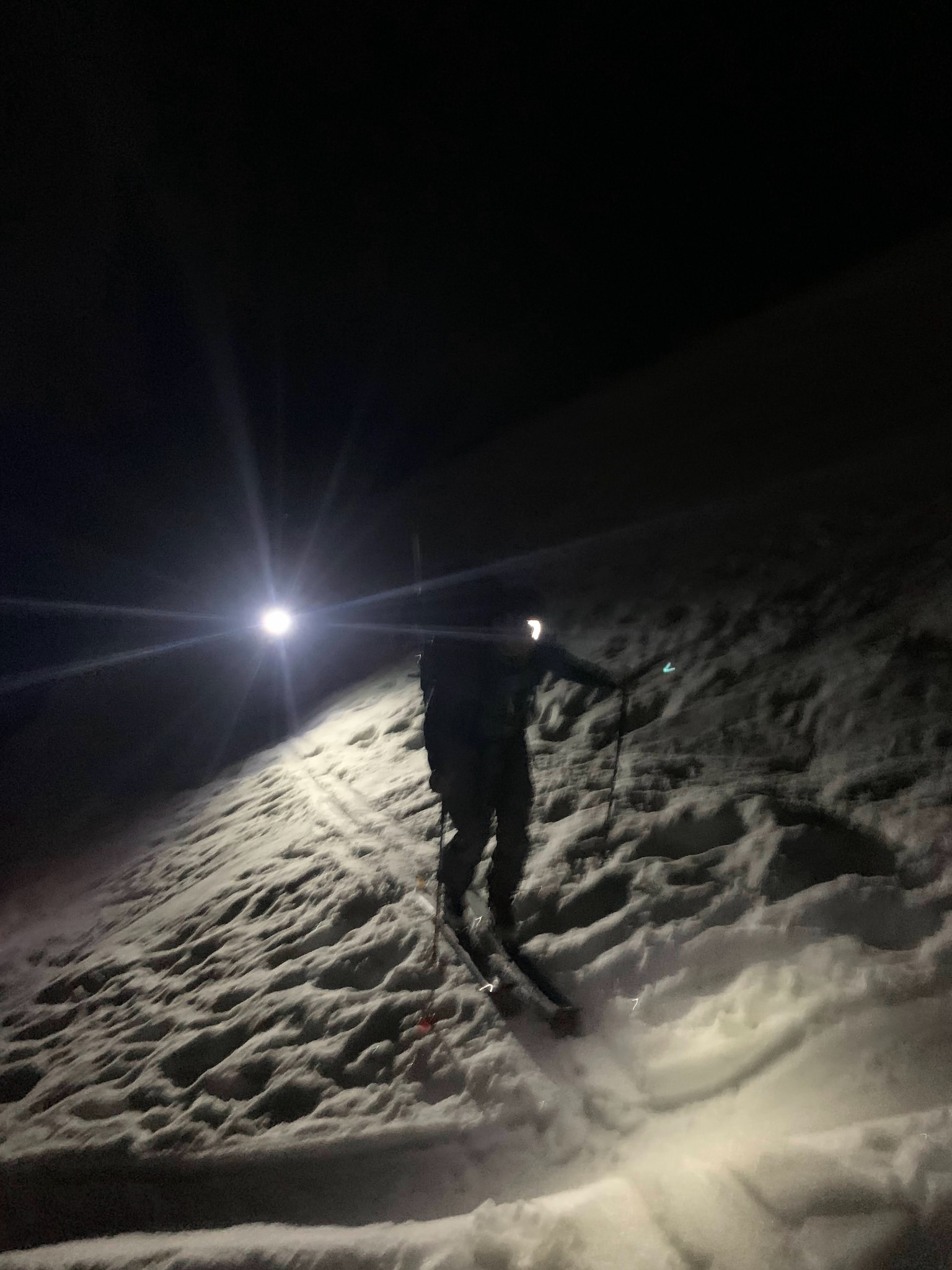 Skinning up Avalanche Gulch around 1am.
Skinning up Avalanche Gulch around 1am.
Crampons up The Heart
Once I arrived at Helen Lake, I could see the most intimidating part of the climb - the climb past The Heart to Red Banks. It was a blank expanse of pale icy white in the darkness, faintly illuminated by a line of dozens of climbers headlamps stretching up the mountain past the distant cliffs far above us. This slope was only 1 mile long, but gained +2,360 ft at up to 60% slope near the end. In addition, the cliffs were unstable, sending rocks and shards of ice tumbling down the slope, threatening to injure or kill anyone foolish to climb the slope. If you did climb and slipped, it could be a >2,000 ft fall down icy snow. In fact, one year before a three-person climbing team slipped and fell, resulting in one dying from head trauma and the others with multiple broken bones and series injuries. Even more worrying, there were dozens of potentially inexperienced climbers above us, increasing the risk that they could slip and fall into us, dislodge rocks or ice, or drop equipment onto us as we climbed.
 View from Helen Lake of climbers hiking up to Red Banks pre-dawn.
View from Helen Lake of climbers hiking up to Red Banks pre-dawn.
With all this in mind, we prepared ourselves for the climb. Tank had made it to Helen Lake for a while and was starting to get cold from sitting still, so started immediately up the slope to Red Banks. I followed quickly after as I had already switched to crampons and wanting to get a head start on Dan and Sam, who I suspected would be much faster than me.
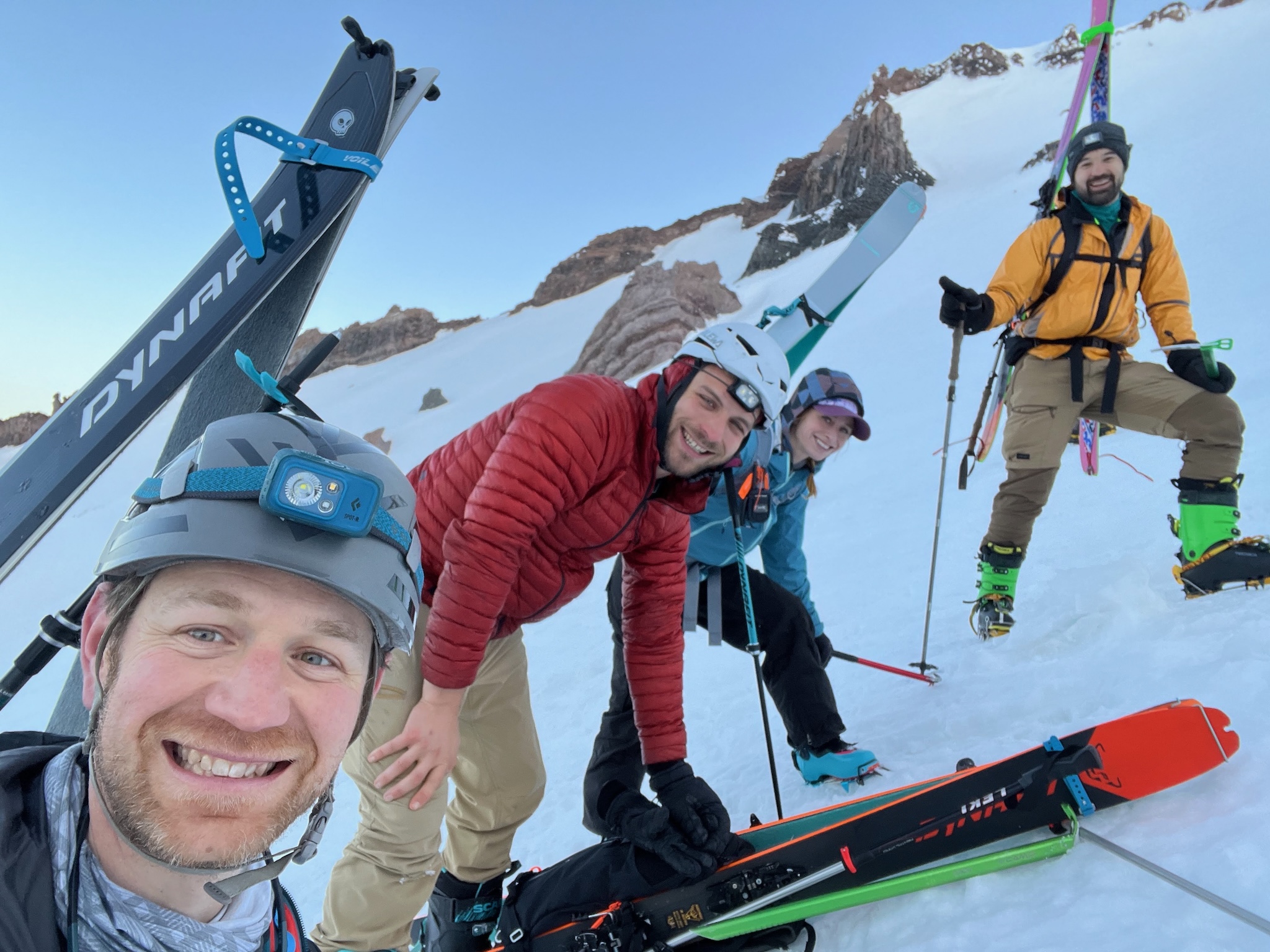 The group partway up to Red Banks, early in the climb.
The group partway up to Red Banks, early in the climb.
As I trudged up the long slope, I noticed that altitude was taking a toll on me. This entire climb is above 10,000 ft, higher than I’d ever been in my life. I noticed that every time I would exert myself I’d get dizzy and at times nauseous. I couldn’t take more than ten steps at time before I had at stop, take several deep breaths, and regain my strength. If I pushed harder than this, get dizzy and put myself at risk of a fall.
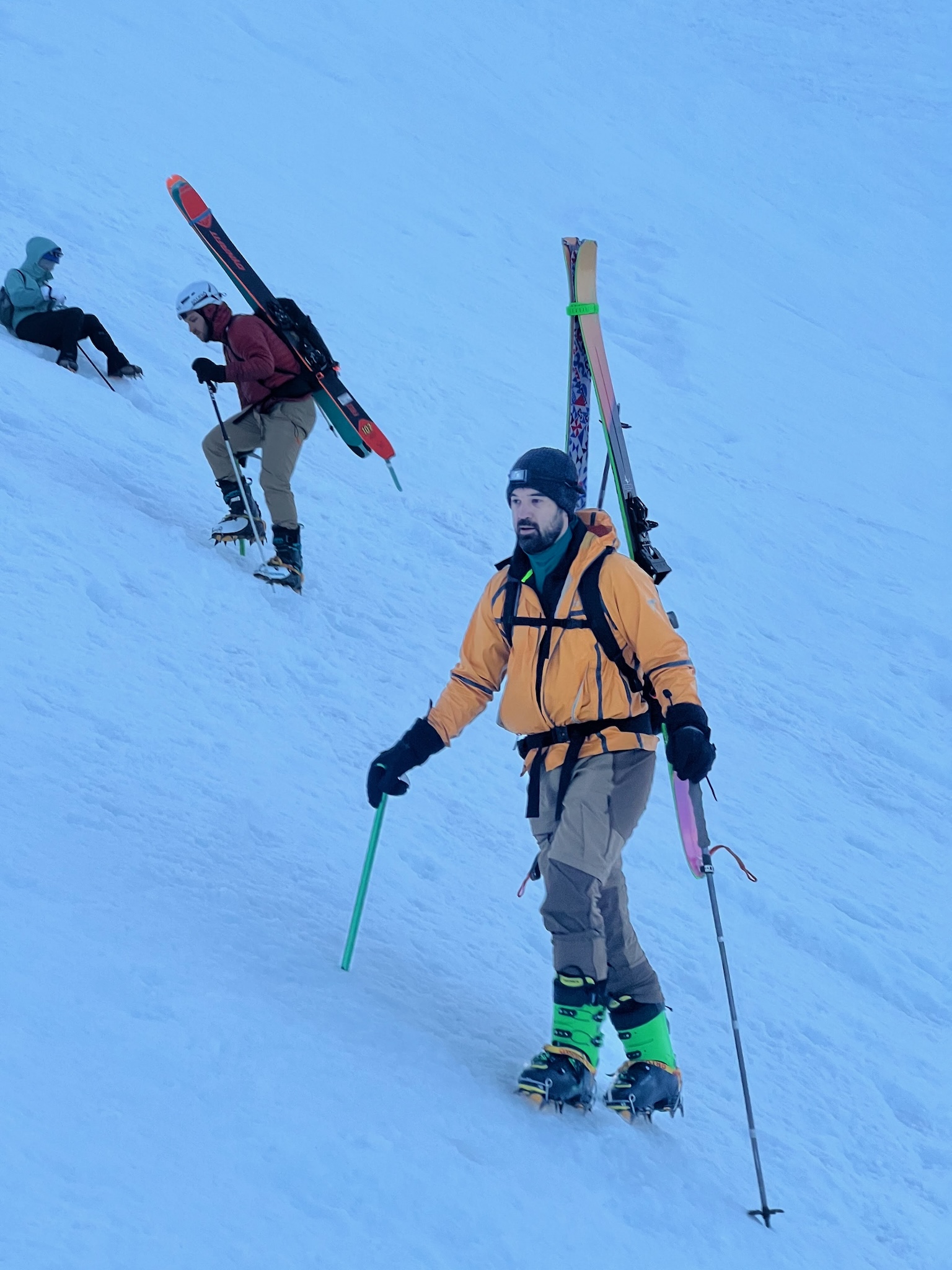 I found serpentine and French-Step to be the easiest.
I found serpentine and French-Step to be the easiest.
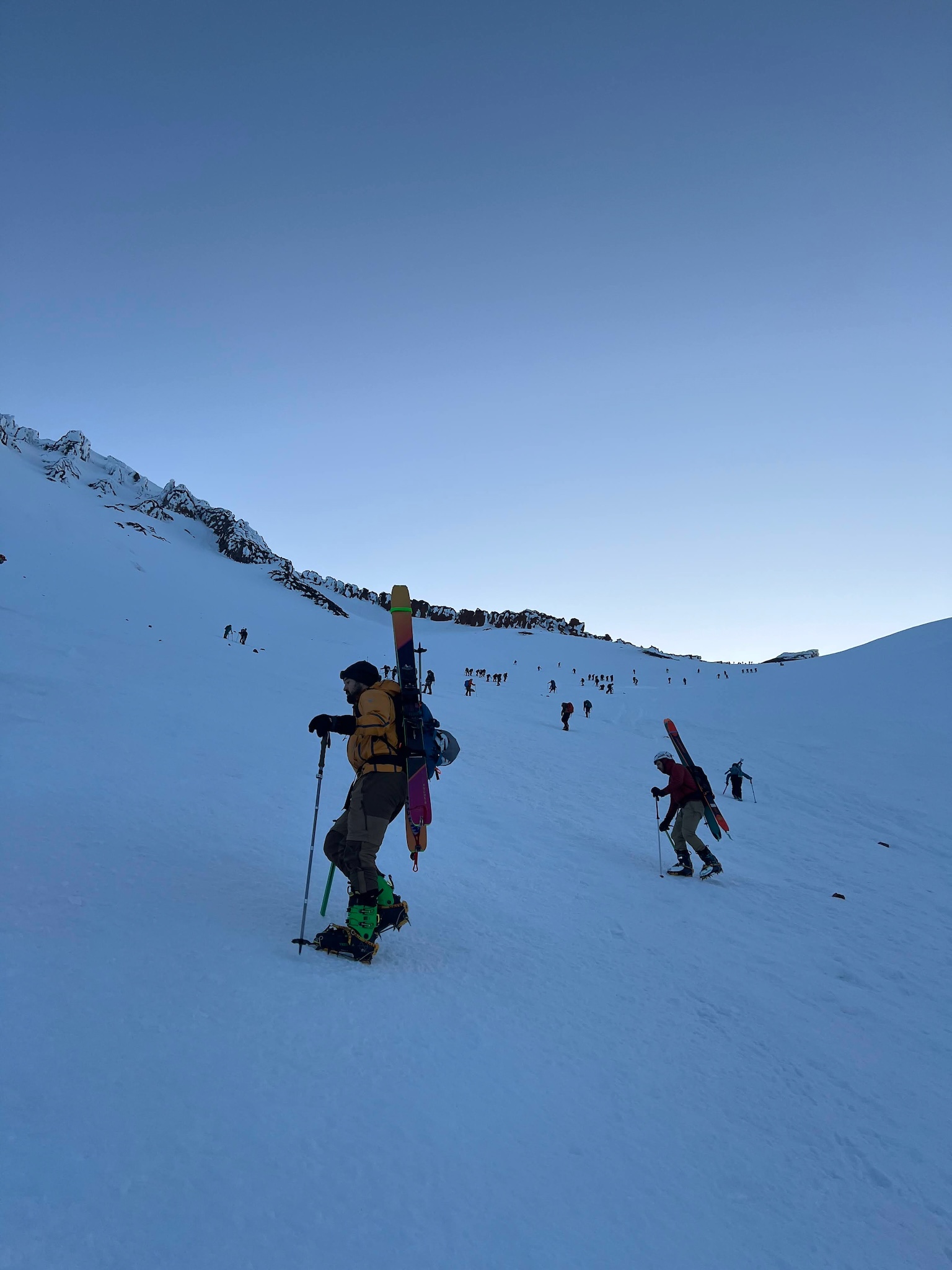 Despite climbing for hours, the top often seemed no closer.
Despite climbing for hours, the top often seemed no closer.
I kept trudging on, but was really struggling with the altitude and soon fell behind the group. Tank was incredible, sailing far ahead of the group so quickly that I soon lost sight of her. She apparently had some adventures of her own, including a malfunctioning crampon that she had to stop and repair in the steepest section while perched on a snow shelf clinging to her ice axe.
As I saw the others get further and further ahead, I seriously contemplated stopping and turning around. The slope is massive and almost uniform smooth icy snow, and because I hadn’t researched the route I didn’t realize just how long and far a climb it was (1 mi, +2,360 ft elevation). Luckily, I spotted a rock outcrop about 0.2mi and 600ft from the top that others were resting on and headed to it. I took a rest at a the rock, had some water and food, and chatted with an awesome bro Seth for a bit to regain my strength and confidence. Seth was shocked to hear that it was my first time on backcountry skis and first time mountaineering, but was extremely encouraging and pointed out that we had plenty of time yet to summit and were actually right on schedule.
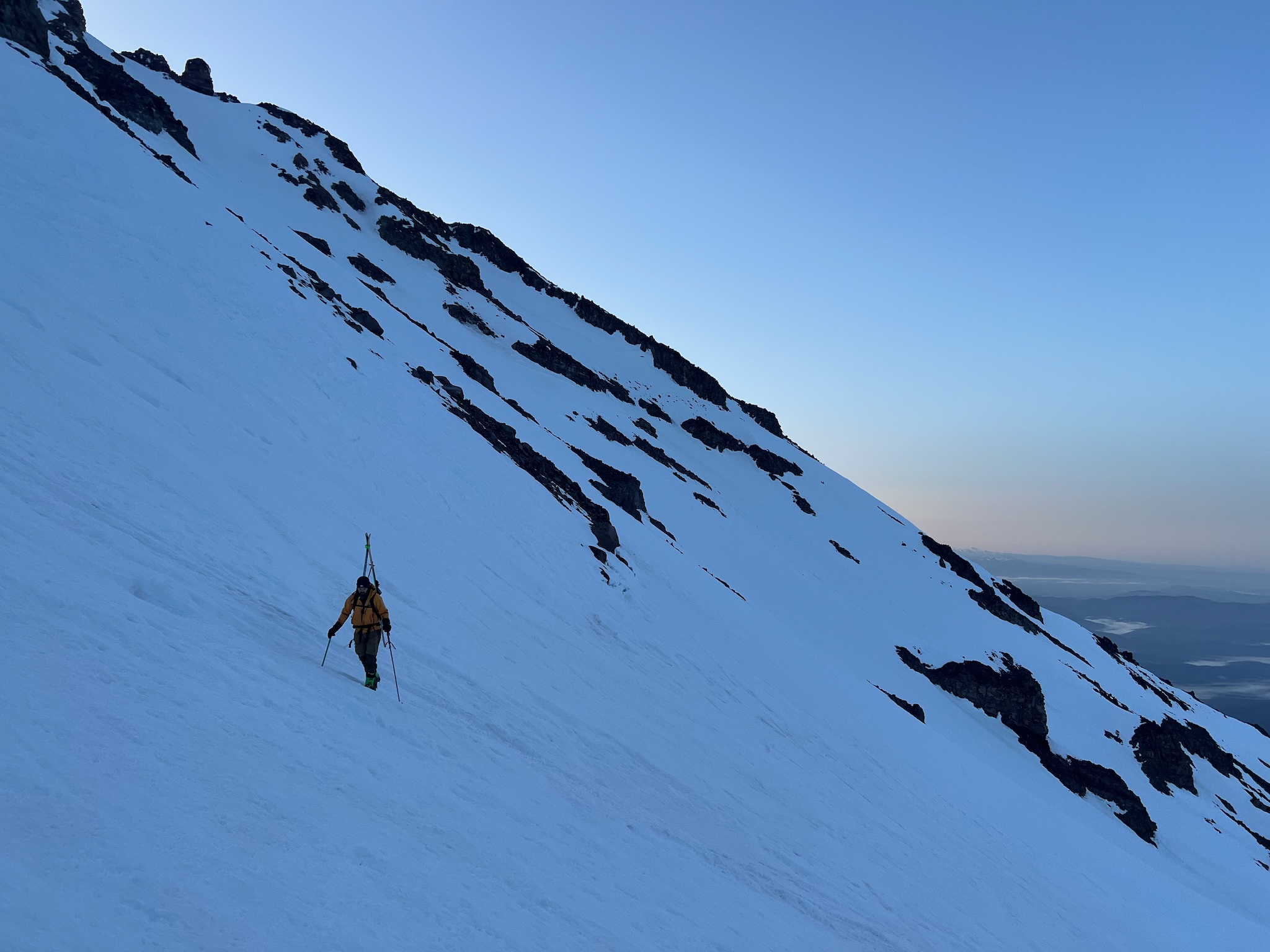 The pre-dawn light was gorgeous.
The pre-dawn light was gorgeous.
After the rest, I continued upwards, finally making it to the top of the Red Banks (12,800 ft) at 8:50am after a 4.5 hr climb. At the ridge I met up with the group and carefully stepped over a crevasse - technically a Bergschrund at the top of the glacier on the far side. We took a well deserved reset next to the Bergschrund - Tank actually peed in it!
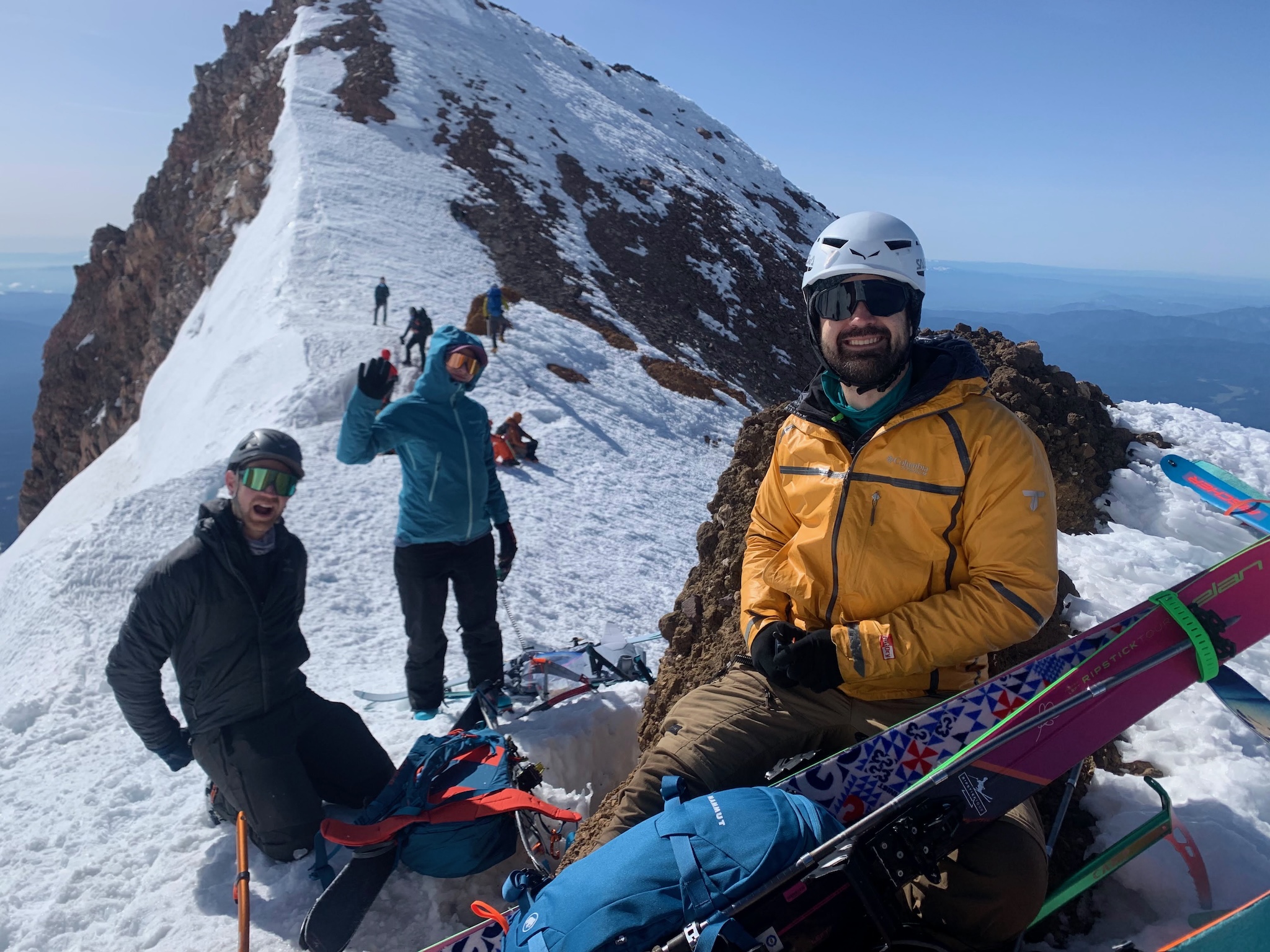 Chilling on a crevasse.
Chilling on a crevasse.
After the brutal climb up to Red Banks, the next slope was the small “Birthday Hill” (+400 ft to 13,200 ft). After a good rest, we tackled this hill without much incident, reaching the top at 10:20 am.
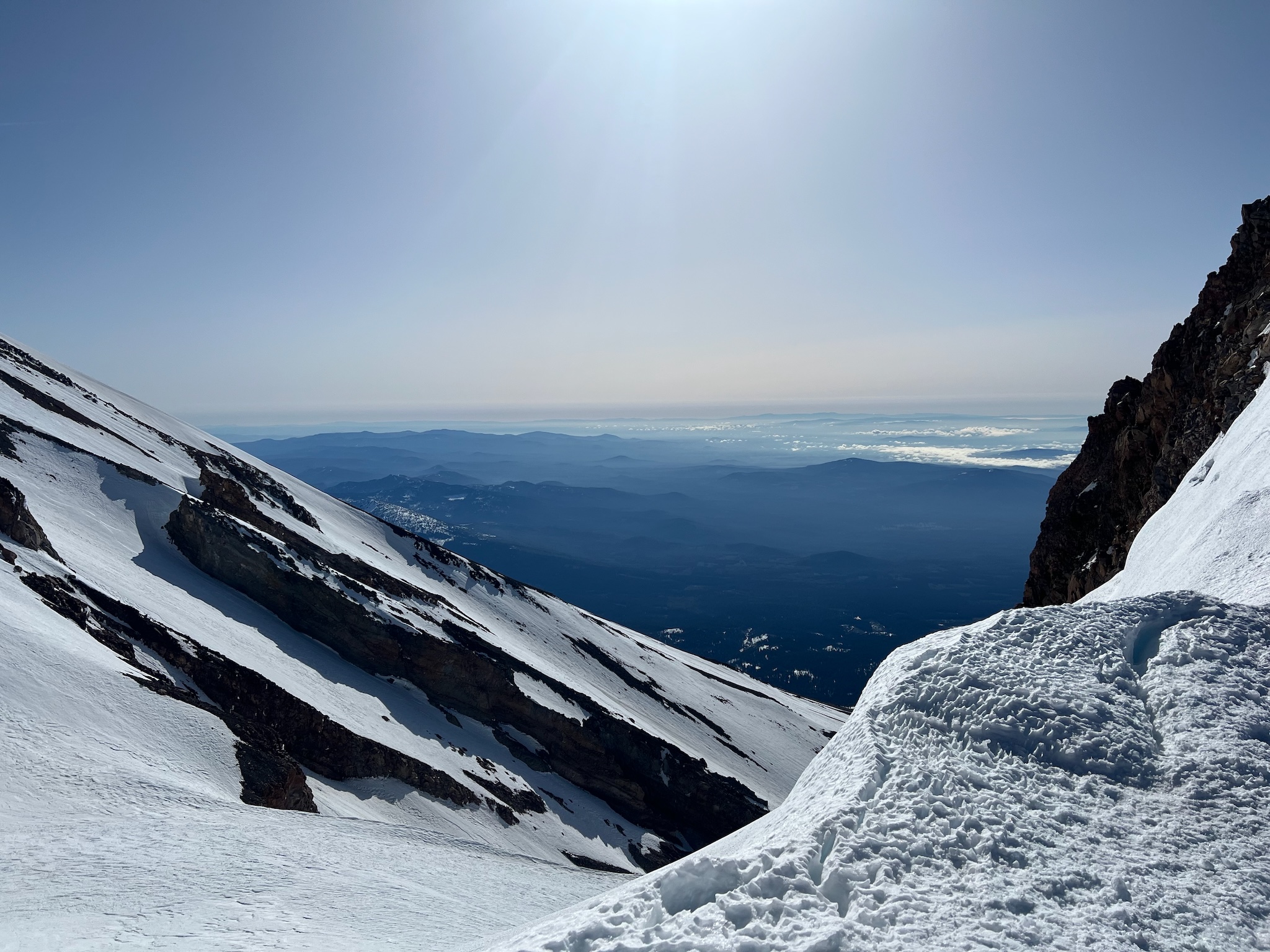 View from the top of Red Banks
View from the top of Red Banks
Misery Hill
At the top of Birthday Hill, we saw our final boss - the aptly named “Misery Hill”. It rose +640ft to 13,840 ft in front of us - a stark slope exposed to direct wind and sun and covered with shards of ice.
To boost our morale for the final big climb, Dan and Tank sang a song they’d re-written: “Misery Hill - that’s where I want to ski! (windy windy)”. Appropriate, as we all felt like Weezers. After a rest I was still exhausted, so I told Dan, Tank, Sam to go ahead and leave me with a radio.
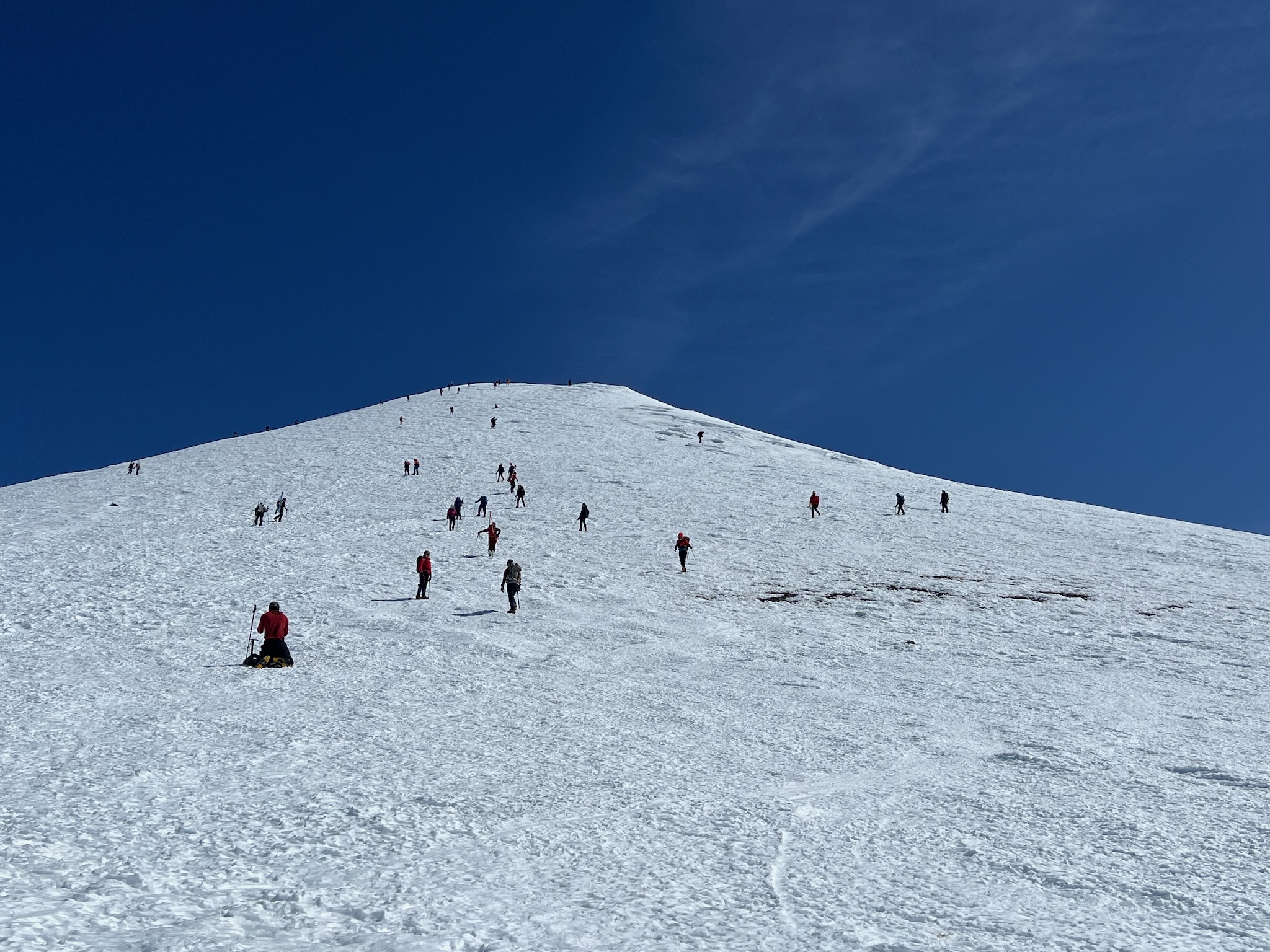 The view up Misery Hill.
The view up Misery Hill.
I eventually decided to continue, but left my skis at the base. This turned out to be a great idea! I both didn’t have to carry them up and got to walk down Misery hill instead of ski what Dan later described as “the worst snow he’d ever experienced”.
Misery Hill was such a struggle. 5 steps and rest. Howling wind. Blazing sun. Even without a pack it was misery. The only consolation was it seemed like everyone else was struggling too. I could see Tank plodding ahead, and the other climbers around me would often stop and stare painfully into the distance for several breaths before taking another few steps upward. I ended up taking another rest halfway up and chatted with some other bros who were also very encouraging. After more than an hour of misery I finally reached the top (13,840 ft) at 11:50 am. Just over 300 ft left to the summit!
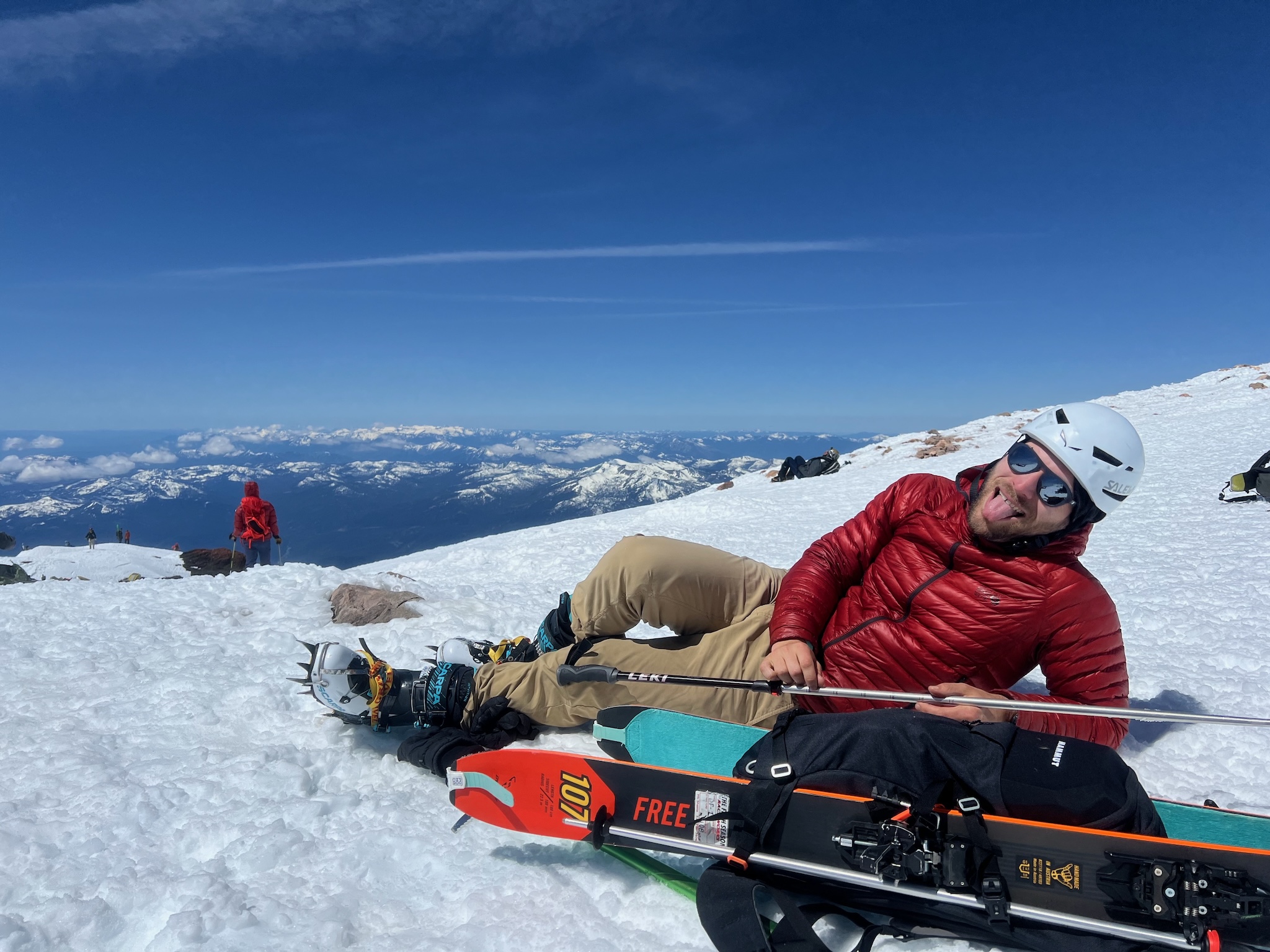 Sam celebrating at the top of Misery Hill.
Sam celebrating at the top of Misery Hill.
Push to the Summit
After finally making it to the top of Misery Hill, we waited for Dan to go use a WAG bag (poop). Tank tried too but was apparently unsuccessful. Once back, we all popped some painkillers and they convinced me to make the final push to the summit. We walked through flat area to summit, then up the final two slopes (+339 ft). The rest of the group dropped their skis and we took the final winding steps to the rocky summit. With the goal in sight it was surprisingly easy and we made it to the top (14,179 ft) at exactly 1pm - right on schedule!
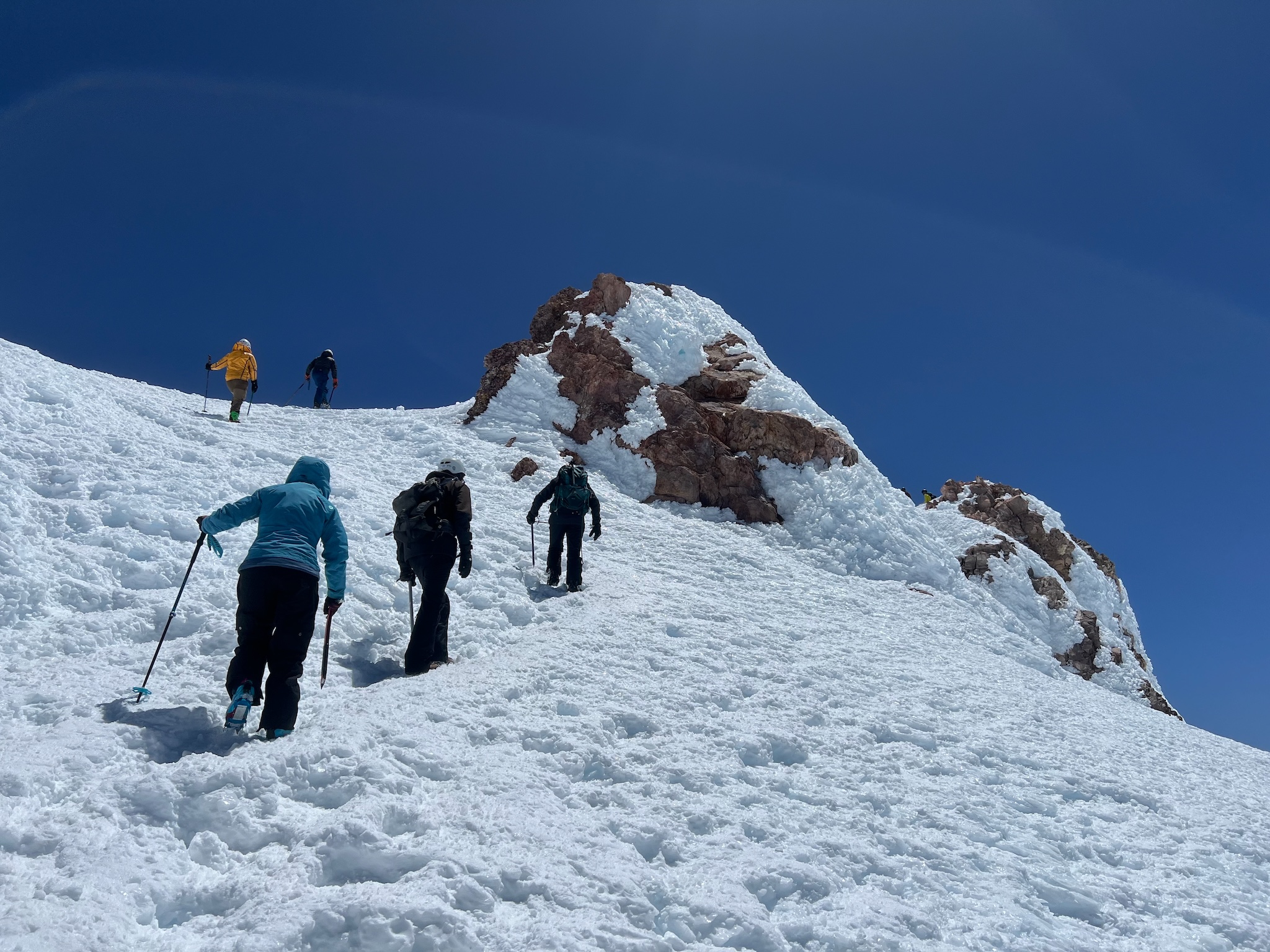 The final push to the summit.
The final push to the summit.
At the summit we celebrated, took in the stunning view, chatted with other climbers, and took plenty of pictures. I was jealous another person had brought a can of Shasta cola to celebrate. We took a group photo on the tip-top, but Dan was the only one brave (or foolish) enough to stand over the icy ledge looking straight down hundreds of feet.
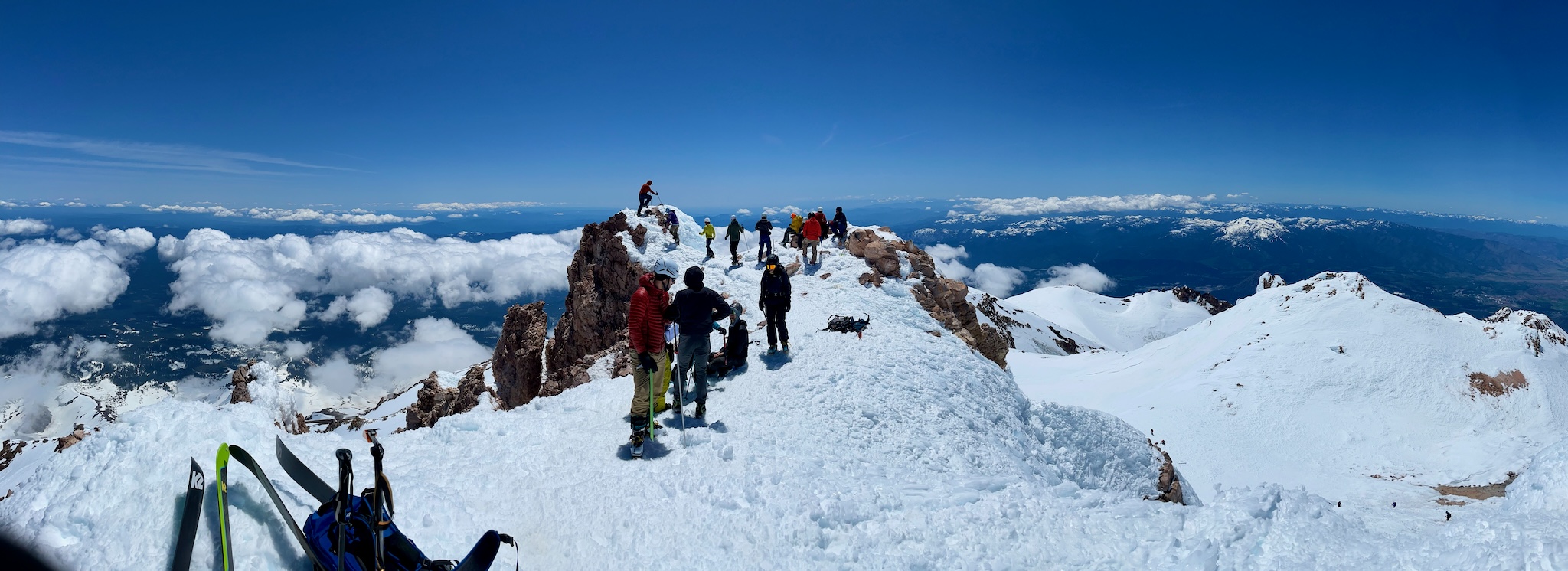 Panoramic view of the summit.
Panoramic view of the summit.
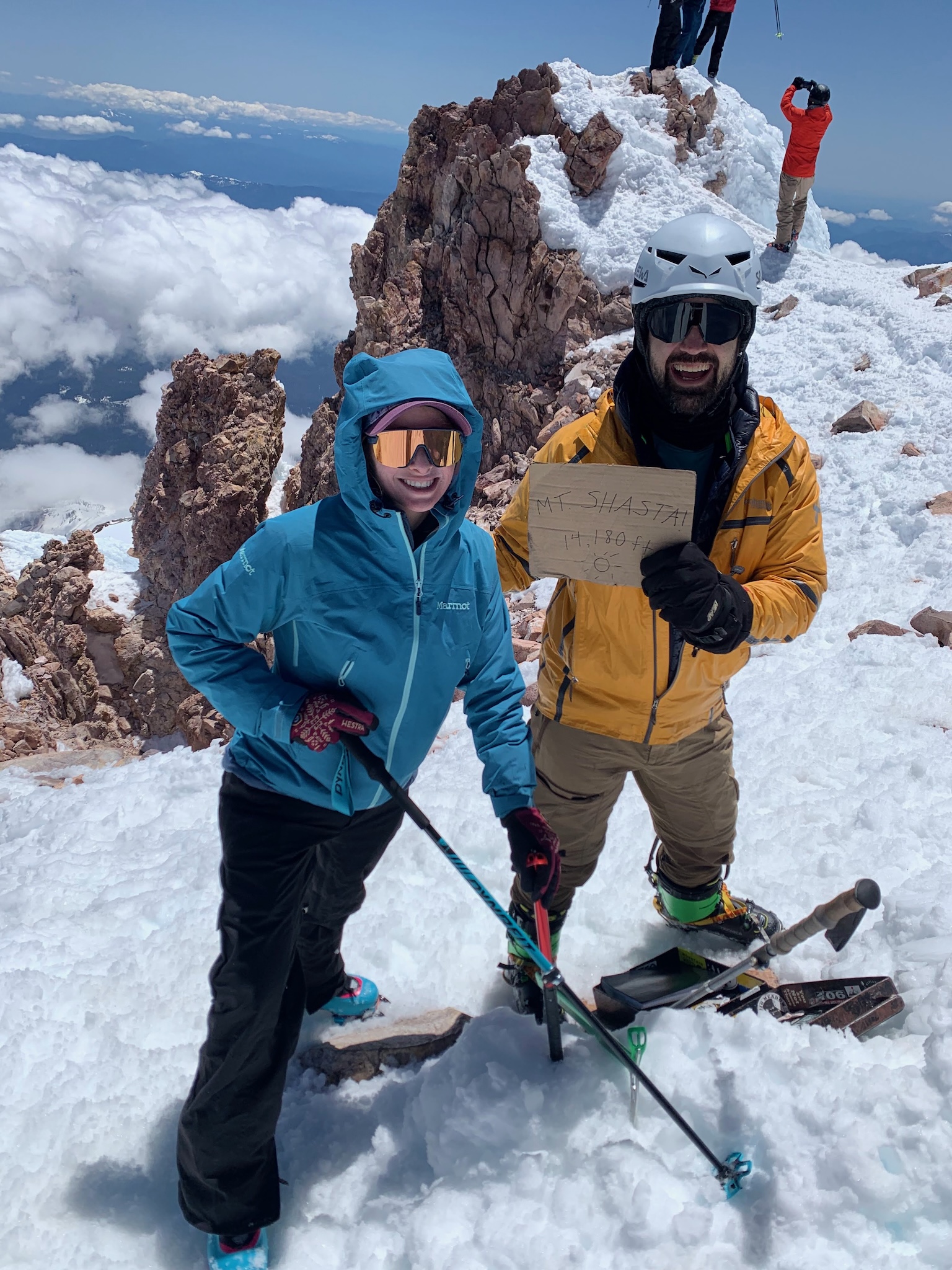 Shasta’s sign isn’t nearly as fancy as Whitney.
Shasta’s sign isn’t nearly as fancy as Whitney.
We all wrote in the logbook - Tank’s quote was “We crushed it! Feeling Great!” while my quote was “never again”. Before we descended, Tank did a headstand despite Sam’s protestations.
 Our logbook entries.
Our logbook entries.
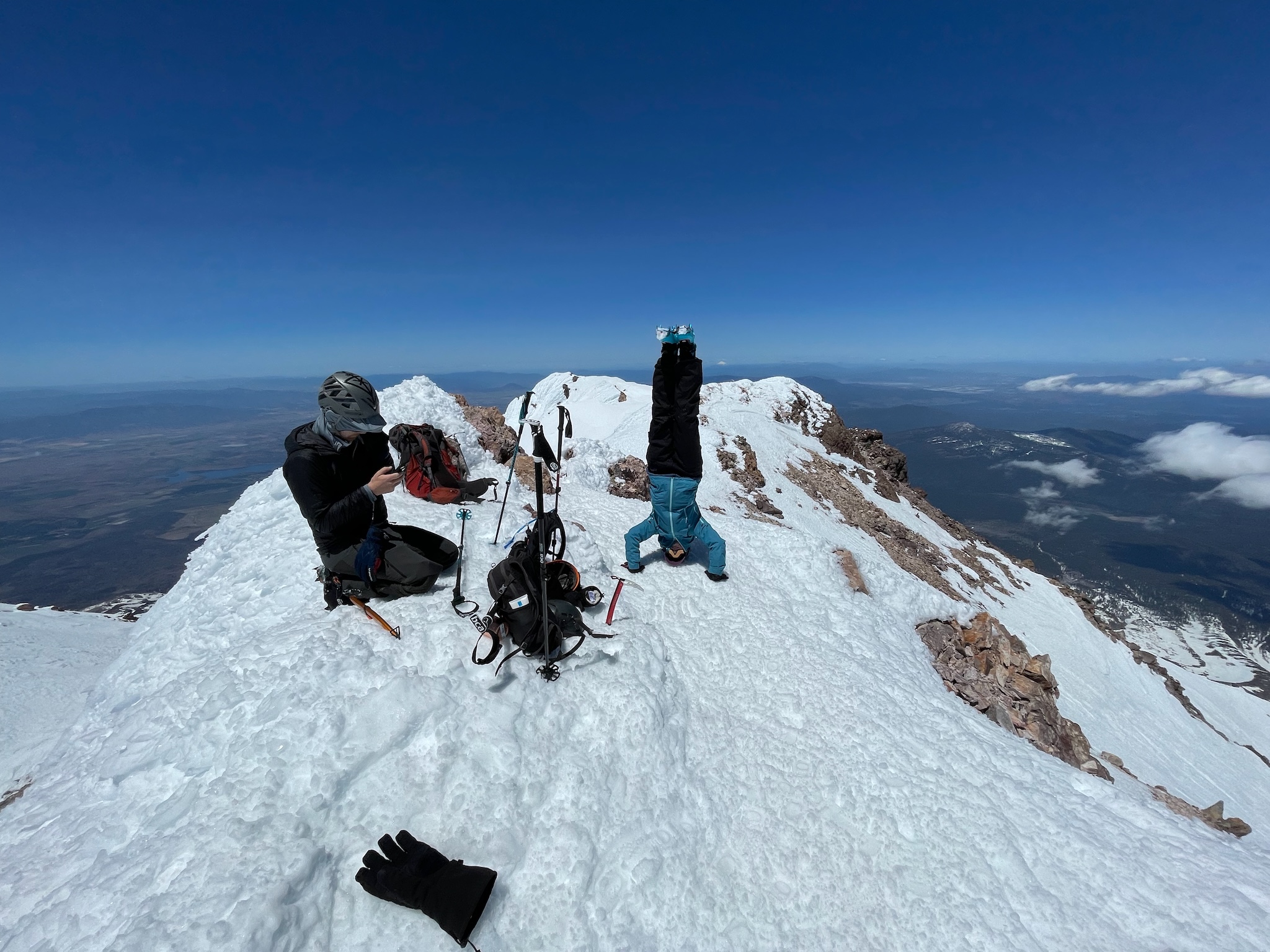 Tank holding the world on her head. Too bad she didn’t keep her skis on!
Tank holding the world on her head. Too bad she didn’t keep her skis on!
Summit Descent
After the summit, I walked back down, telling the group I’d meet them at the bottom of misery hill. Plunge stepping was surprisingly quick and easy - so nice to be descending. I got to back to my pack at base of misery hill at 2 pm, far faster than I expected.
Waiting at Misery Hill
Back at my pack, I sorted all my gear, prepared my skis, drank some water, ate some food, and began an unexpectedly long wait.
 My view of solitude at the base of Misery Hill
My view of solitude at the base of Misery Hill
Almost 30min later, Dan and Tank radioed that Sam had lost his phone and had to return to the summit to look for it. The plan was for Sam to take the radio and they would ski down misery hill to me for us to wait for Sam together. I then sat for another 30min without hearing anything as Dan and Tank slowly and cautiously picked their way down what they described as “the worst snow they’d ever skied” - being extra careful not to fall. They finally met up with me at 3:10pm, after I’d been sitting for 40 min.
Once we met up, we discussed the situation. We were worried about Sam’s delay, so Tank and I decided to ski ahead since we were the weaker skiers while Dan waited for Sam. Splitting up wasn’t ideal, but it was the best option we had at that time as it was getting late and the snow would start to ice later in the day. We decided that Tank and I would ski down to Helen Lake at 10,440 ft so we would at least be near others who were camping, and if we didn’t see Dan and Sam by 6pm, we’d ski out to the TH and call SAR on them.
We headed out and I finally left my long watch at 3:20pm after sitting at the bottom of Misery Hill for almost 1.5 hrs!
Survival Skiing
Tank and I started skiing down extra cautiously. I was on skis for the first time in a year since my ACL surgery starting at 13,200 ft and needing to ski 6,250 ft down a mountain to make it back to safety. A bad fall or re-injuring myself wasn’t an option. In addition, we had split the group and Tank had a dead phone and I only had a phone and radio, no Garmin, so we knew we couldn’t afford any more complications or mistakes.
We gingerly figured out the way down and did tight turns down Birthday Hill to the top of Red Banks. Luckily the snow was in great conditions and was soft and fluffy from the sunny spring conditions. Nothing like Misery Hill.
At the top of Red Banks, we debated for a while whether we should risk walking back across the Bergschrund crevasse on the edge of a steep glacier carrying our skis, or whether we should try to find a safe, ski-able chute between the Red Bluffs. After a lot of debate we skied down to check out the chutes and found a wide, easy route between the rock towers. Once onto the face of Avalanche Gulch below the Red Banks, we started to enjoy the skiing a bit more, doing wide careful turns across the mountain and making our way towards Helen Lake.
It turns out there was a reason that Sam had been delayed. He had skinned back to the summit and found his phone, but after skiing down Misery Hill had gotten disoriented. He asked as stranger for directions, which was a mistake, as they sent Sam the wrong direction down a glacier! Luckily, he quickly realized his mistake, figured out the right route with his phone, and climbed back to the base of Misery Hill where he met up with Sam.
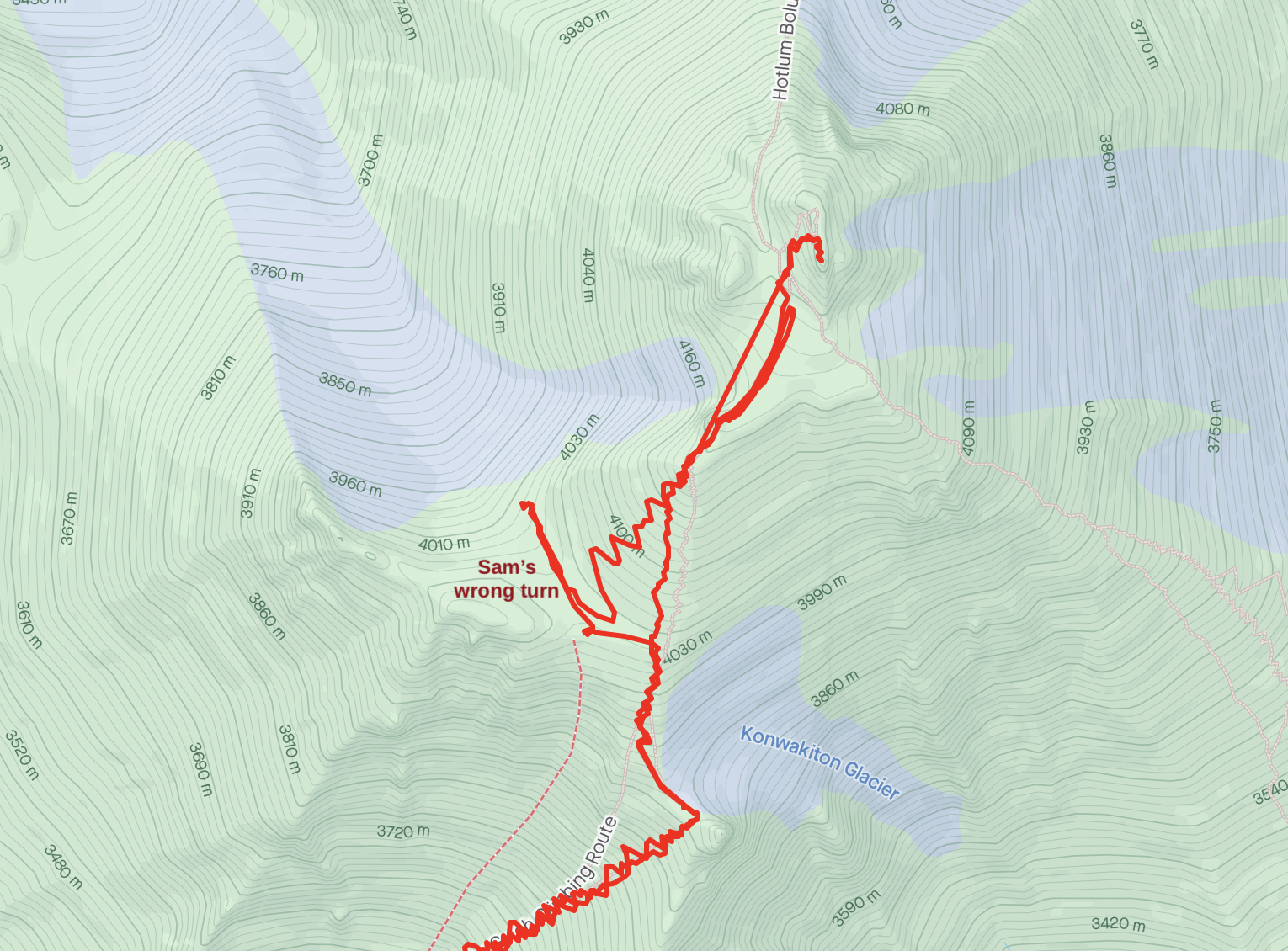 Sam’s wrong turn down a glacier.
Sam’s wrong turn down a glacier.
After about 15min of Tank and me skiing below Red Banks, during a rest Tank shouted “I see them!”. Sam and Dan were happily skiing down the face of Avalanche Gulch a few hundred feet above us. It was an incredible relief to see them safe and happy and was so much quicker than we expected.
Backcountry Bliss
The rest of the descent down the Avalanche gulch gulleys was pure backcountry skiing bliss. Perfect spring snow in full sun with wide open slopes all to ourselves. 4,000 feet of pure bliss.
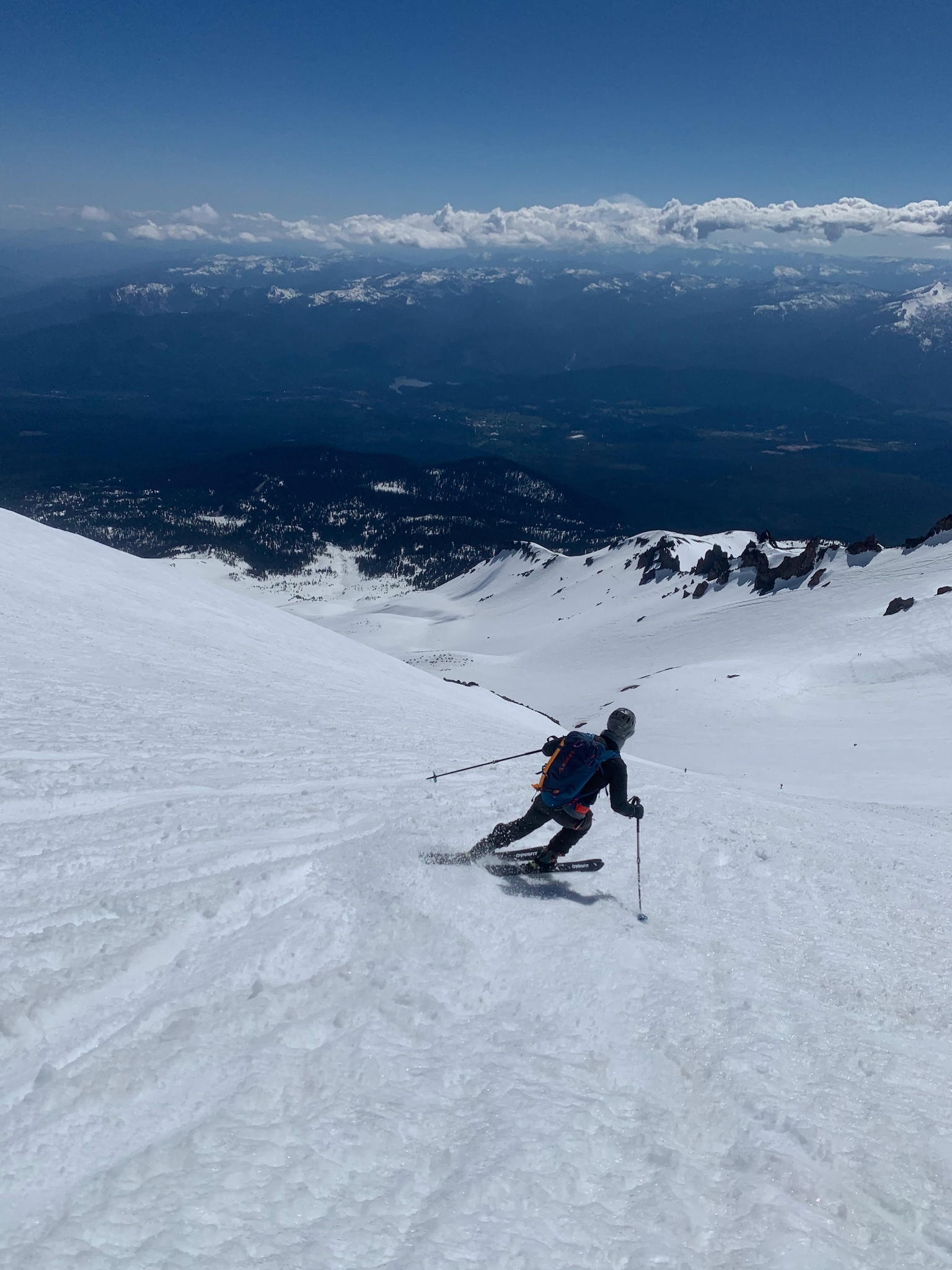 Dan carving it.
Dan carving it.
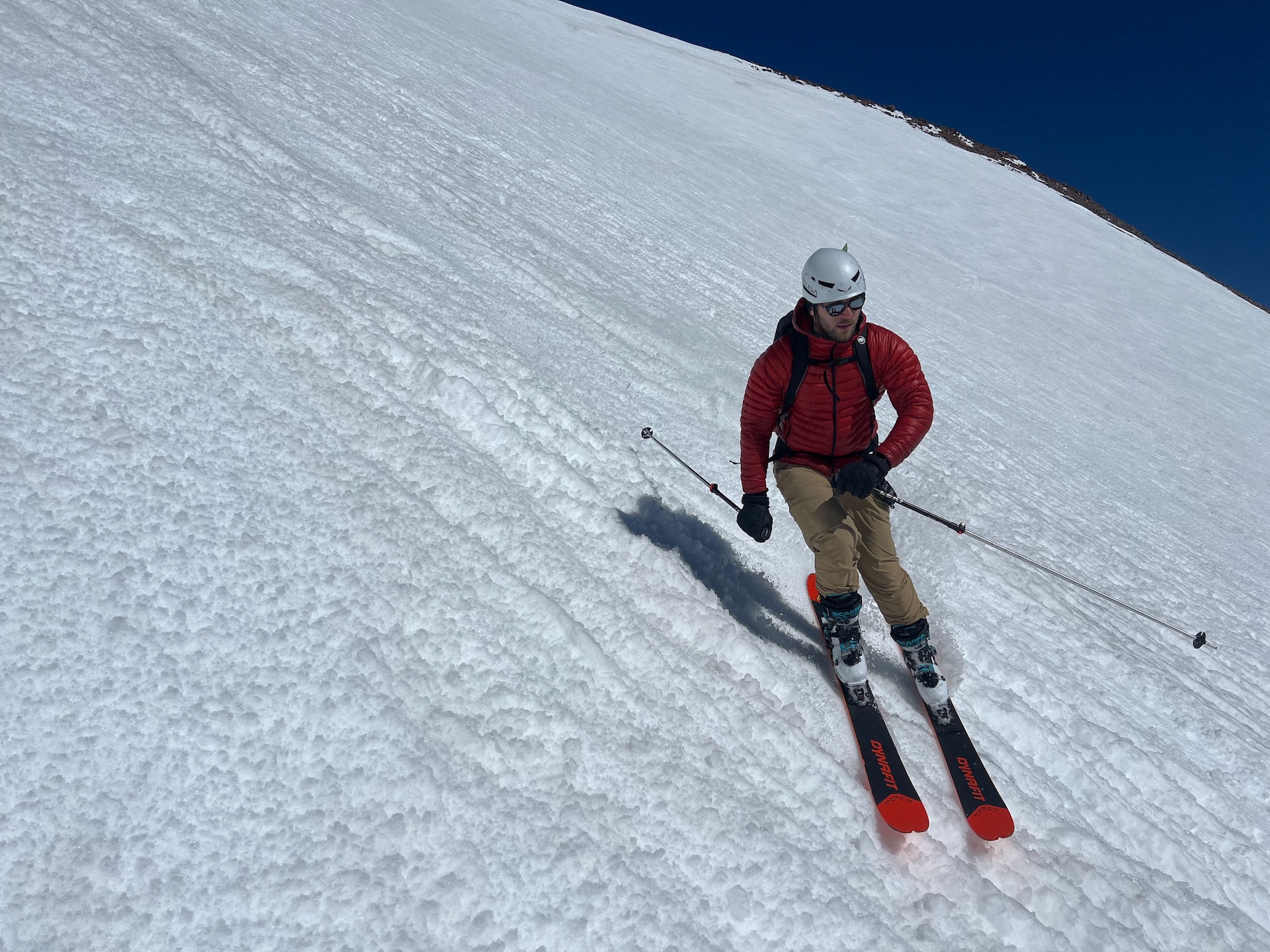 Sam ripping it.
Sam ripping it.
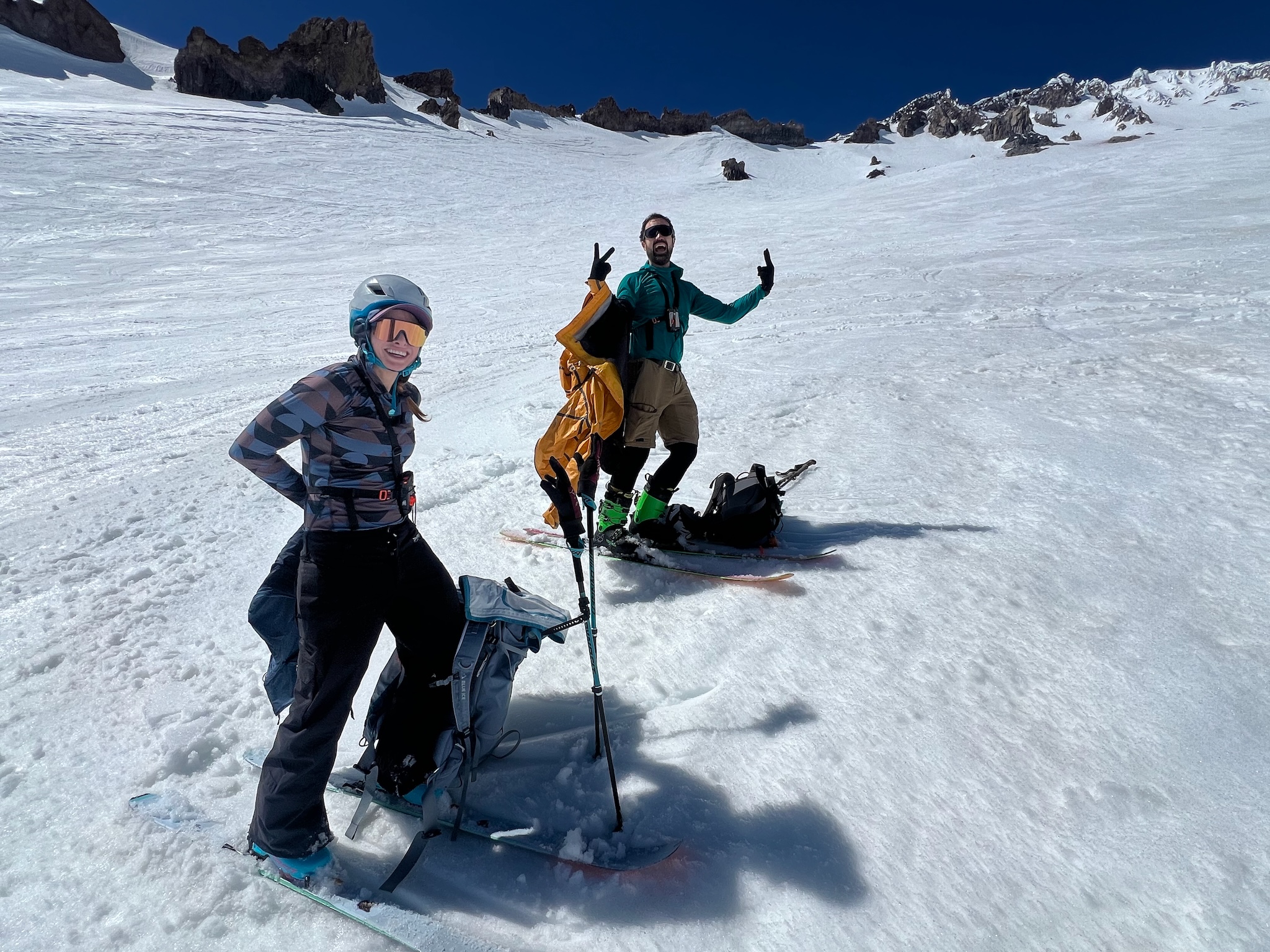 Tank and I had cautious fun.
Tank and I had cautious fun.
By 4:30 pm we’d reached the bottom of the main slopes at 7,300 ft and started into ski tracks through the woods. The tracks were narrow, icy, and annoying, but still went fairly smoothly and quickly.
We finally made it back to Bunny Flats trail head at 5pm - around 2 hours later than we planned, but with only minor injuries like chapped lips and blisters and tons of great stories to tell! I’ve wanted to climb this mountain for more than 10 years, and it felt great to finally accomplish that goal!
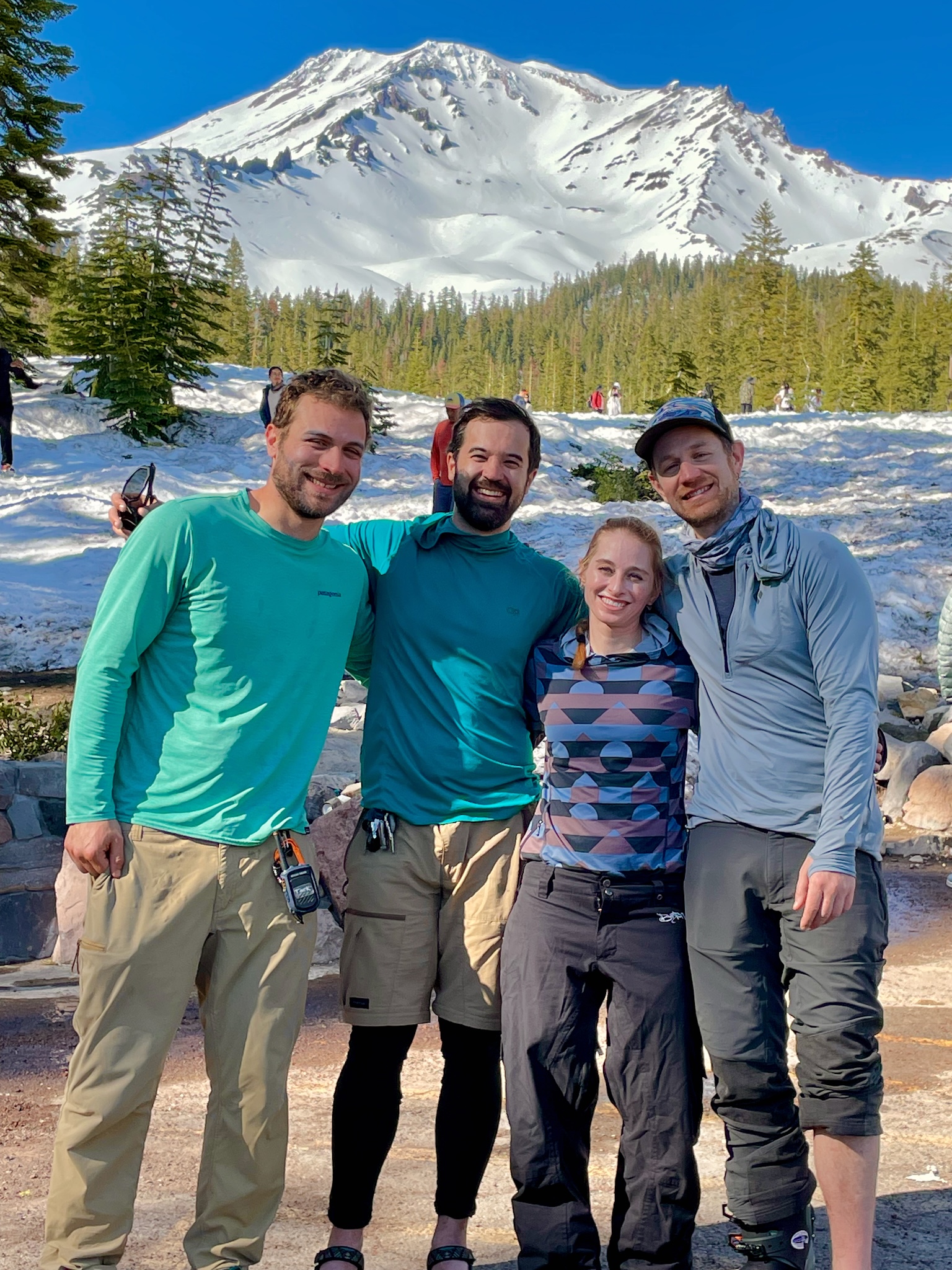 The group after a successful summit.
The group after a successful summit.
After we packed up and examined our minor wounds, we headed eat some well-deserved food! Garmin estimates that I burned 4500 kcal over 16 hours, and perspired >8L of sweat. We needed some food and electrolytes! First that evening at Yaks Shack where we had delicious burgers and the most pungent, painful garlic fries anybody had ever experienced. Then, the next morning at the original Black Bear Diner where we feasted.
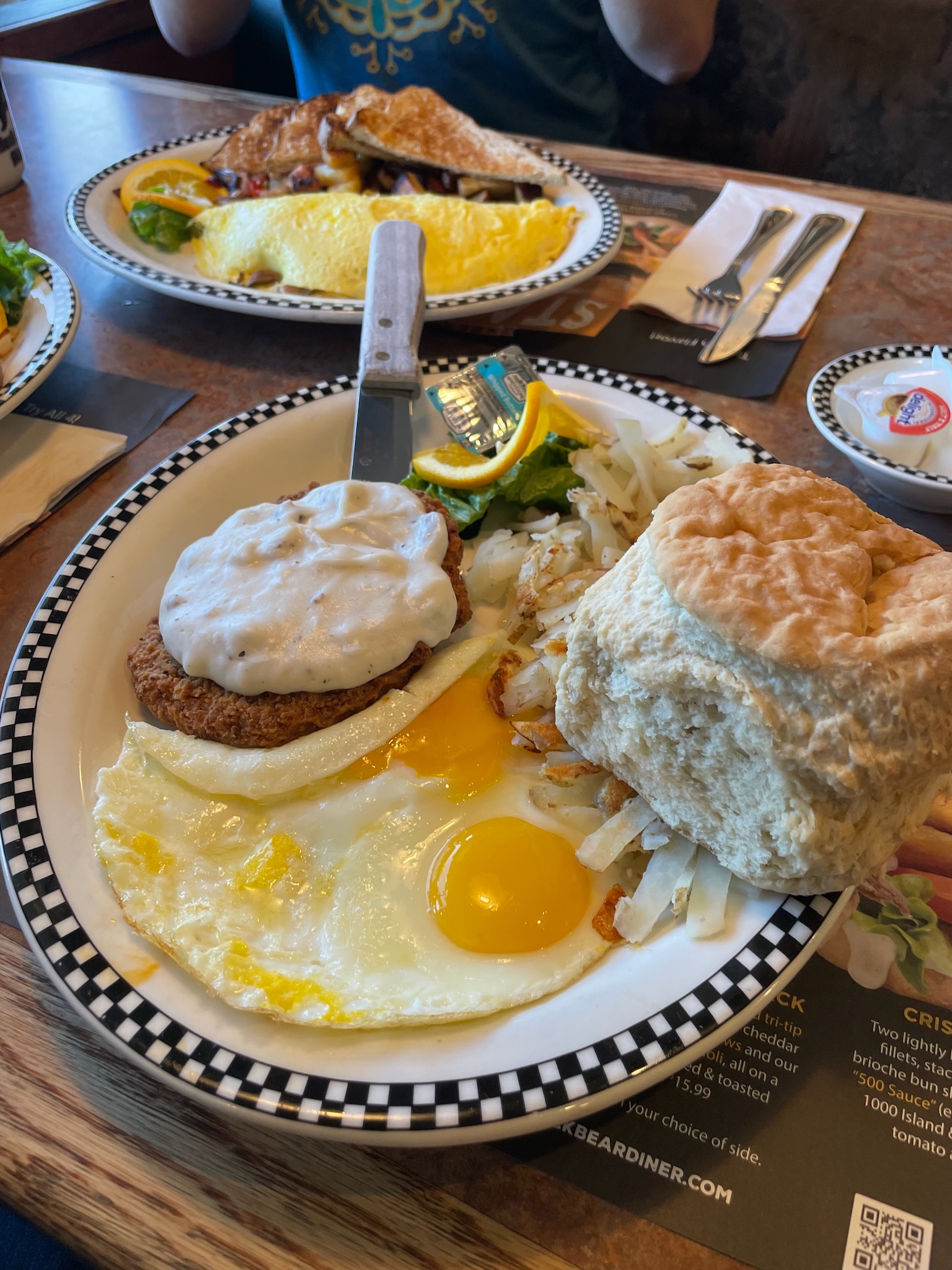 The O.G. Black Bear Diner - biggest biscuit I’ve ever seen.
The O.G. Black Bear Diner - biggest biscuit I’ve ever seen.
Lessons Learned
Things that went well
- Awesome first backcountry mountaineering! This was incredible day of firsts for me - first backcountry ski, first skins, first crampons, first ice axe use, first mountaineering trip, and first time on skis since ACL injury. It went surprisingly well!
- Great communication and planning - We communicated and planned very well, and everything went smoothly overall. Despite numerous small setbacks I never felt in acute danger and never felt like I couldn’t stop, turn around, and descend safely if I needed to.
- A great guide - We went with an experienced guide (Dan) who taught us everything we needed to know!
- Good morale - Our morale was high all day and we never succumbed to whining or being sour, despite being exhausted and somewhat behind schedule.
- Safety first - I was never so committed to summiting that I pushed myself into doing dangerous or stupid things. I knew I was going slowly, but could tell if I pushed myself harder I’d get dizzy, putting myself at risk of a fall. I decided very early in the climb that I was going to continue pushing at a safe pace, but that I was happy just to be on the mountain and wasn’t married to the idea of getting to the summit.
Things to Improve
- Don’t underestimate altitude - it was slow-going because I couldn’t exert myself or get my heart rate much above resting before starting to get dizzy.
- Drink more water. I didn’t pee for the entire 16 hrs, likely meaning I was dehydrated which contributed to the dizziness. I likely should have chugged 1-2 L of water before setting out to fully hydrate.
- Drop the skis at the bottom of misery hill. It was a relief to shed the weight and the snow higher was terrible anyway.
- Get better radios - we had two Garmin Inreaches and two Rocky Talkies, but during critical moments still had trouble communicating. The Garmins were too slow and the radios didn’t have enough range. We’re looking into GMRS radios.
- Trust my gut about safety. I spent a long time as we approached Helen Lake around 4-5 am fearfully trying to skin up steep slopes with ski crampons. I eventually got so worried about slipping that I switched to boot crampons, which were much more secure. I think it would have been even faster if I had switched earlier.
- Train and practice with my gear more. Looking back, I think I would have been more comfortable with skins and ski crampons if I’d practiced more. Also, I should have put my helmet on when we passed Helen lake, but only donned it halfway up the Heart. Finally, I realized once we’d reached the trail head that I’d skied the entire mountain with my boots in flexible “walk” mode instead of rigid “ski” mode. All of these could have been mitigated by practicing to become more familiar with my equipment.
- Research the route more. I could have done a better job understanding the different sections of the route to set internal expectations better. In addition, this would have allowed us to specify when we would stop to meet re-assemble the group along the route if we got separated on climbs (which we did). Instead, I spent much of the time at up the Heart wondering if they’d left me behind, and Tank spent a long time wondering where we were or if we’d gotten lost.